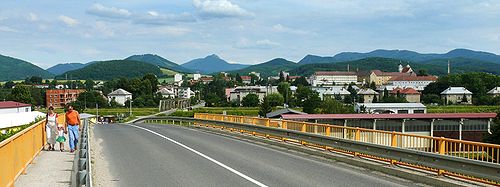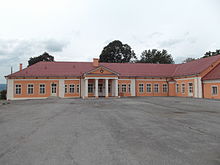Ilava
| Ilava | ||
|---|---|---|
| coat of arms | map | |

|
|
|
| Basic data | ||
| State : | Slovakia | |
| Kraj : | Trenčiansky kraj | |
| Okres : | Ilava | |
| Region : | Stredné Považie | |
| Area : | 24.302 km² | |
| Residents : | 5,464 (Dec. 31, 2019) | |
| Population density : | 225 inhabitants per km² | |
| Height : | 255 m nm | |
| Postal code : | 019 01 | |
| Telephone code : | 0 42 | |
| Geographic location : | 49 ° 0 ′ N , 18 ° 14 ′ E | |
| License plate : | IL | |
| Kód obce : | 513156 | |
| structure | ||
| Community type : | city | |
| Urban area structure: | 3 districts | |
| Administration (as of November 2018) | ||
| Mayor : | Viktor Wiedermann | |
| Address: | Mestský úrad Ilava Mierové námestie 16/31 019 01 Ilava |
|
| Website: | www.ilava.sk | |
| Statistics information on statistics.sk | ||
Ilava (German Illau , Hungarian Illava ) is a city in northwest Slovakia with 5464 inhabitants (as of December 31, 2019) and the seat of an okres of the same name .
geography
Ilava lies in the heart of the Ilavská kotlina basin , part of the larger Považské podolie valley , between the White Carpathians to the northwest and the Strážovské vrchy mountains to the southeast of the city. The built-up area extends to the left of the Waag , separated from the river itself by the Kočkovský kanal (German Canal of Kočkovce), on a corridor terrace of Porubský potok . The 49th parallel runs straight through the city. The city center lies at an altitude of 255 m nm and is 23 kilometers from Trenčín , 57 kilometers from Žilina and 148 kilometers from Bratislava .
The urban area includes the municipal parts Ilava , Iliavka (incorporated in 1971) and Klobušice (incorporated in 1971).
Neighboring municipalities are Pruské in the north, Košeca in the northeast and east, Košecké Podhradie in the southeast, Horná Poruba in the south, Dubnica nad Váhom in the southwest, Slavnica in the west and Sedmerovec in the northwest.
history
In the Porubská dolina valley there was a settlement and burial site of the Lusatian culture and an Iron Age settlement of the Puchau culture in the Young Bronze Age .
The city was first mentioned in writing in 1332 as Leua (according to other sources as Lewa in 1339 ) and developed as a settlement below an old castle. At that time Ilava was a country town and had certain rights, which were, however, repeatedly challenged by castellans from the surrounding castles. Some development took place at the beginning of the 15th century, when the town was given the right to hold two annual fairs, but the growth came to an abrupt end in 1432 when a battle between the Hungarian troops and one between Ilava and Košeca Campaign of returning Hussites took place, in which the city was badly affected. However, the city was able to recover from this event and in the 15th century it was the seat of a small domain.
In the early modern period, Ilava was a small town that was subordinate to a landlord, but retained its market rights and was the location of regional economic activity. Various guilds were housed in the city, among them tailors, shoemakers and weavers the most important craftsmen. In 1598 the city had 104 houses. A brewery is mentioned in 1635, which existed in various forms until the 20th century. In the 17th century, the Trinitarian order settled in part of the old castle and built a monastery. In 1828 there were 148 houses and 1233 inhabitants in the city. In the 19th century Ilava was a district town, in 1856 a state prison was set up on the site of the dissolved monastery, which still exists today. In the late 19th century there was a brewery, match factory, brick factory and distillery. In 1894 the city was ravaged by a major fire.
The place in Trenčín County belonged to the Kingdom of Hungary until 1918 and then came to Czechoslovakia or Slovakia. From the 1930s, the city stagnated economically when industrial companies settled in the Waagtal, such as B. in neighboring Dubnica nad Váhom, but not in Ilava. In 1960, Ilava also lost the status of an administrative seat when the seat of the Okres was centralized to Považská Bystrica .
In 1996, Ilava regained its status as the seat of an okre.
population
According to the 2011 census, Ilava had 5,391 inhabitants, including 5,195 Slovaks , 33 Czechs , eight Moravians , four Roma , three Magyars and two Carpathian-Germans , Russians , Russians and Ukrainians . Nine residents indicated a different ethnic group and 131 residents gave no information about the ethnic group .
4,385 residents committed themselves to the Roman Catholic Church , 67 residents to the Evangelical Church AB , 13 residents to the Pentecostal movement, nine residents to the Apostolic Church, eight residents each to the Jehovah's Witnesses and to the Greek Catholic Church and six residents to the Orthodox Church . A total of 30 residents professed a different denomination. 564 inhabitants had no denomination and the denomination of 300 inhabitants was not determined.
Buildings and monuments
- Illau Fortress , a castle in the Middle Ages and modern times, rededicated to a monastery in the late 17th century, state prison since 1856
- Roman Catholic All Saints Church in Baroque style from the early 18th century
- Bell tower, originally Gothic, today mostly designed in Baroque style
- Renaissance style building of the former vicarage
- The building of the former brewery from 1635
- Country chateau in the Klobušice district from the 19th century with an English park
traffic
The 1st-order road 61 from Bratislava to Žilina passes through Ilava and crosses the 2nd-order road 574 ( Pruské - Diviacka Nová Ves ) in the city . Ilava has a connection to the D1 motorway ( E 50 , E 75 ) via a feeder road (II / 574A ).
The Bratislava – Žilina railway runs through the city , with the Ilava train station northeast of the city center. This is approached by several daily local train pairs. There are connections to express trains in the Trenčianska Teplá and Púchov stations, and to IC and EC trains in the Trenčín station (as of the 2015/16 timetable).
sons and daughters of the town
- Ivan Baranka (born 1985), ice hockey player
- Emmerich Bjelik (1860–1927), apostolic field vicar
- Marcel Hossa (* 1981), ice hockey player
- Tomáš Kopecký (* 1982), ice hockey player and two-time Stanley Cup winner
- Richard Pavlikovský (* 1975), ice hockey player
- Natália Prekopová (* 1989), biathlete
- Tomáš Tatar (* 1990), ice hockey player
See also
Individual evidence
- ↑ Results of the 2011 census (Slovak) ( Memento of the original from March 5, 2016 in the Internet Archive ) Info: The archive link was inserted automatically and has not yet been checked. Please check the original and archive link according to the instructions and then remove this notice.
Web links
- Entry on e-obce.sk (Slovak)




